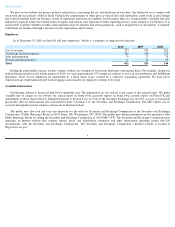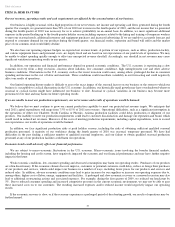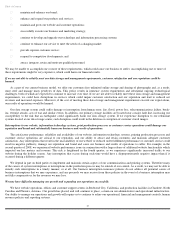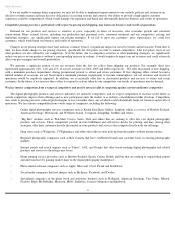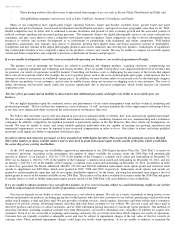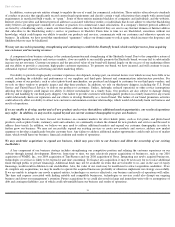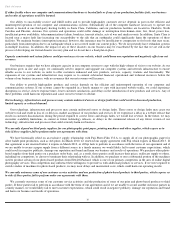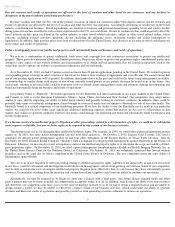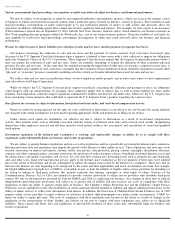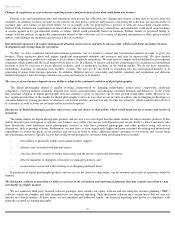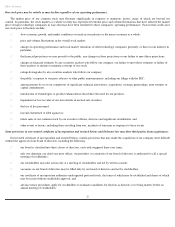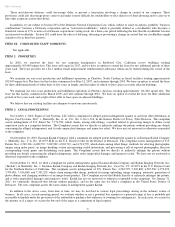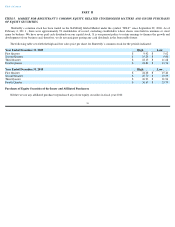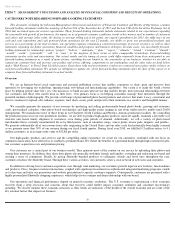Shutterfly 2011 Annual Report Download - page 21
Download and view the complete annual report
Please find page 21 of the 2011 Shutterfly annual report below. You can navigate through the pages in the report by either clicking on the pages listed below, or by using the keyword search tool below to find specific information within the annual report.
Our net revenues and results of operations are affected by the level of vacation and other travel by our customers, and any declines or
disruptions in the travel industry could harm our business.
Because vacation and other travel is one of the primary occasions in which our customers utilize their digital cameras, our net revenues and
results of operations are affected by the level of vacation and other travel by our customers. Accordingly, downturns or weaknesses in the travel
industry could harm our business. Travel expenditures are sensitive to business and personal discretionary spending levels and tend to decline
during general economic slowdowns such as those experienced in the U.S. and worldwide. Events or weaknesses that could negatively affect the
travel industry include price escalation in the airline industry or other travel-
related industries, airline or other travel related strikes, safety
concerns, including terrorist activities, pandemic disease (including the influenza virus), inclement weather and airline bankruptcies or
liquidations. In addition, high gasoline prices may lead to reduced travel in the United States. Any decrease in vacation or travel could harm our
net revenues and results of operations.
Failure to adequately protect our intellectual property could substantially harm our business and results of operations.
We rely on a combination of patent, trademark, trade secret and copyright law and contractual restrictions to protect our intellectual
property. These protective measures afford only limited protection. Despite our efforts to protect our proprietary rights, unauthorized parties may
attempt to copy aspects of our website features and functionalities or to obtain and use information that we consider proprietary, such as the
technology used to operate our website, our production operations and our trademarks.
As of December 31, 2010, we had 37 patents issued and more than 20 patent applications pending in the United States. We intend to pursue
corresponding patent coverage in other countries to the extent we believe such coverage is appropriate and cost efficient. We cannot ensure that
any of our pending applications will be granted. In addition, third parties have in the past and could in the future bring infringement, invalidity,
co-
inventorship or similar claims with respect to any of our currently issued patents or any patents that may be issued to us in the future. Any
such claims, whether or not successful, could be extremely costly to defend, divert management’
s time and attention, damage our reputation and
brand and substantially harm our business and results of operations.
Our primary brand is “Shutterfly.”
We hold registrations for the Shutterfly and other trademarks in our major markets of the United States
and Canada, as well as in the European Community, Mexico, Japan, China, Australia and New Zealand. Our competitors may adopt names
similar to ours, thereby impeding our ability to build brand identity and possibly leading to customer confusion. In addition, there could be
potential trade name or trademark infringement claims brought by owners of marks that are similar to Shutterfly or one of our other marks. The
Shutterfly brand is a critical component of our marketing programs. If we lose the ability to use the Shutterfly service mark in any particular
market, we could be forced to either incur significant additional marketing expenses within that market, or elect not to sell products in that
market. Any claims or customer confusion related to our marks could damage our reputation and brand and substantially harm our business and
results of operations.
If we become involved in intellectual property litigation or other proceedings related to a determination of rights, we could incur substantial
costs, expenses or liability, lose our exclusive rights or be required to stop certain of our business activities.
Third parties may sue us for infringing their intellectual property rights. For example, in 2009, we settled three patent infringement lawsuits
against us. In 2010, two more patent infringement lawsuits were filed against us. On October 1, 2010, Express Card Systems, LLC filed a
complaint for alleged patent infringement against us and four other defendants in the Eastern District of Texas, Tyler Division. And on
December 10, 2010, Eastman Kodak Company (“Kodak”)
filed a complaint for alleged patent infringement against Shutterfly in the District of
Delaware. Likewise, we may need to resort to litigation to enforce our intellectual property rights or to determine the scope and validity of third-
party proprietary rights. On December 13, 2010, we filed a patent infringement complaint against Kodak and Kodak Imaging Network, Inc. in
the United States District Court for the Northern District of California.
On January 31, 2011, we voluntarily dismissed that lawsuit without
prejudice, and on the same day we filed a complaint in the United States District of Delaware. The new complaint asserts the same claims of
infringement against Kodak.
The cost to us of any litigation or other proceeding relating to intellectual property rights, whether or not initiated by us and even if resolved
in our favor, could be substantial, and the litigation would divert our management’
s efforts from growing our business. Some of our competitors
may be able to sustain the costs of complex intellectual property litigation more effectively than we can because they have substantially greater
resources. Uncertainties resulting from the initiation and continuation of any litigation could limit our ability to continue our operations.
Alternatively, we may be required to, or decide to, enter into a license with a third party. Any future license required under any other
party’s patents may not be made available on commercially acceptable terms, if at all. In addition, such licenses are likely to be non-
exclusive
and, therefore, our competitors may have access to the same technology licensed to us. If we fail to obtain a required license and are unable to
design around a patent, we may be unable to effectively conduct certain of our business activities, which could limit our ability to generate
revenues and harm our results of operations and possibly prevent us from generating revenues sufficient to sustain our operations.
Table of Contents
17



